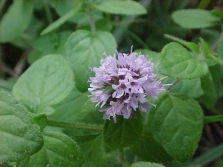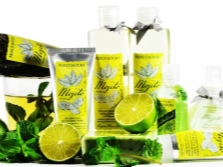What is the difference between mint and lemon balm?

Despite the fact that mint and lemon balm are similar to each other, there are some differences between them. What is the difference between mint and lemon balm?
Both plants belong to the Lamiaceae family, but mint belongs to the genus Mint, and lemon balm belongs to the genus Melissa.
If you want to know all about these amazingly beneficial herbs, check out our articles:
They can be grown both in the country and at home on your windowsill.
Read and take our advice into service. Use mint and lemon balm, add them to your favorite dishes and put their healing properties into practice. And of course don't forget to drink tea with mint and tea with melissa.
The main differences between these herbs are presented in the following table.
| difference | Mint | Melissa |
| Stem | Straight | Branched |
| Flowers | purple | purple |
| Inflorescence form | ears of corn | false whorls |
| Height | up to 1 m. | up to 1.5 m. |
| leaf shape | elongated | ovoid |
| Aroma | Sweetish menthol | Slim lemon |
| Essential oil | Tones up | Soothes |
Distinguishing mint from lemon balm is not as difficult as it seems at first glance.






For those who want to know about all the subtleties and differences, we have prepared the following table.
| Characteristics | Mint | Melissa |
|---|---|---|
| Appearance | The stem is straight, the flowers are collected in inflorescences, resembling ears of corn, and have a purple color. Basically, the maximum height reaches 1 m, although usually the plant is much lower. The leaves are predominantly oval or lanceolate. | The stem branches, the flowers gather in false rings, painted in purple tones.The maximum height of the plant reaches 1.5 m, although most often it is much lower. The leaves are ovoid in shape. |
| Kinds | There are a lot of species in the mint genus, including hybrids, but most often there are 25 main species, among which peppermint has more benefits and a wider halo of distribution. | There are only 5 species in the plant genus. In Russia, most often you can find the only type of lemon balm - lemon balm. |
Where does it grow? | Mint is grown in Europe, temperate latitudes of Russia, including Siberia and the Far East. Many species are found in the southern territories, closer to the coastal strip. The plant prefers moist soil and plenty of sunlight. In the wild, it is often found on the banks of reservoirs, fields and meadows. | Melissa is grown in the northern countries of Africa, in Europe and some Asian countries. It also grows in temperate latitudes, including Russia. Prefers, basically, more southern areas. It is sensitive to excess moisture in the soil. In the wild, the plant is found in the undergrowth, ravines, gorges. |
spice making method | In this case, both plants have the same method of making the spice. Leaves and flowers are dried in a dark place, and then crushed and hermetically packed. | |
How and where to choose a spice? | Spices from both plants can be prepared independently, or can be purchased at the store. However, crushed mint is much easier to find than lemon balm. | |
| Peculiarities | Mint has strong aphrodisiac properties, as well as a refreshing menthol aroma. | Melissa has a spicy smell with light notes of lemon. The plant is a large honey plant, therefore it is actively grown near apiaries. |
Characteristics | Both plants are not only cultivated, but also grow in the wild. Officially recognized as medicinal plants and contained in many herbal preparations. | |
| It grows almost all over Russia. Contains a large amount of essential oils. | It prefers southern regions, although it is also found in temperate latitudes. The content of essential oils is significantly lower than that of mint. | |
Nutritional value and calories | 100 grams of mint contains 70 kcal. Mint also has the following nutritional value:
| 100 grams of lemon balm contains 49 kcal. The nutritional value of the plant is as follows:
|
Chemical composition | Mint contains the following vitamins: A - 212 mcg; B1 - 0.082 mg; B2 - 0.266 mg; B3 - 0.338 mg; B6 - 0.129 mg; B9 - 114 mcg; C - 31.8 mg; PP - 1.706 mg. Minerals:
| Melissa contains the following vitamins: PP - 1.78 mg; PP (niacin equivalent) - 0.95 mg; B9 - 105 mcg; B6 - 0.16 mg; B1 - 0.08 mg; B2 - 0.18 mg; C - 13.3 mg; A - 203 mcg. Minerals:
|
Beneficial features | On this basis, mint and lemon balm are very similar to each other. Both plants are used in medicine and give the body a pleasant tonic effect. | |
Harm | With an overdose of mint, allergic reactions and heartburn are possible, as well as loss of sensitivity to the active components of the plant. | Side effects of lemon balm are possible allergies and slowing down the reaction in case of overdose, as it enhances the effect of sedatives. Perhaps the appearance of drowsiness, weakness in the muscles, lethargy. |
Contraindications | Mint should not be used in the following cases:
| Melissa is not recommended for use in the following cases:
|
Oil | Mint contains a lot of essential oils. Peppermint oil tones the body, gives a feeling of cheerfulness. That is why it is not recommended to inhale it before going to bed. | Melissa oil has the exact opposite effect. In aromatherapy, it is used to treat insomnia, calm the nervous system, so it is advisable to inhale it before bedtime. |
Juice | The juice of both plants is equally beneficial for the gastrointestinal tract. The juice of mint and lemon balm has an analgesic effect and acts as a strong antispasmodic. | |
Application in cooking | Both plants are added fresh to green salads, soups, and vegetable dishes. They are also used as seasonings, added to the marinade when canning vegetables, meat or fish. Both plants are intolerant of heat treatment. | |
| Mint acts more as a natural flavor and is often used in the preparation of desserts and sweets. | Melissa is rarely used in the preparation of sweets. Rather, it acts as an analogue of allspice. It is used specifically as a seasoning, not a flavoring. | |
In medicine | Both plants have approximately the same use, the difference is only in dosages. In addition, lemon balm has a stronger calming effect on the nervous system than mint. | |
In cosmetology | Peppermint is used in cosmetics for oily skin. It helps to narrow the pores and dry the skin, remove oily sheen from the face. The use of mint in hair masks and shampoos helps to increase the blood circulation of the scalp, so there is a rapid growth of hair. | Melissa is more versatile. It is used in home masks and cosmetics for skin care of any type. There are even separate masks for dry skin and oily skin. As part of hair nourishing products, lemon balm helps to get rid of dandruff. |
When losing weight | Due to the high content of menthol, mint helps to reduce appetite, and mint teas completely suppress hunger. The diuretic effect helps to remove excess fluid and harmful toxins from the body. | Melissa calms the nervous system, therefore it is suitable for those people who are prone to stress and experience a constant feeling of hunger. Melissa also allows you to activate the metabolism and has a diuretic effect. |
At home | The range of applications of plants is approximately the same. The difference is only in the culinary industry, where mint is often used to decorate dishes and desserts, unlike lemon balm, which acts as a spice. | |
| cultivation | Mint is an unpretentious plant, but it needs to create favorable conditions in order for it to bring maximum benefits.Mint accepts moist, sandy soil. Requires regular watering. Landing is best done in an open area, where a lot of sunlight falls. Propagation is by seeds or cuttings. When planting in the ground between plants there should be a distance of at least 0.3 m. | Sunny or slightly shaded places are suitable for planting lemon balm. Soil with a small amount of sand is acceptable. Excess moisture should not be allowed, the plant does not accept this. Melissa is propagated by dividing the bush or seeds. When planting with seeds, a distance of at least half a meter should be left between plants, as the bushes grow rapidly. |
Interesting Facts |
|
|
Now you will know for sure what grows in the country - mint or lemon balm. Use these herbs correctly.


























Thank you, now I will know) I confused them all the time.
Thank you, now I will teach everyone!
And we, it turns out, mint is growing. I just looked at the dried one - the leaf is oblong.
Good article!